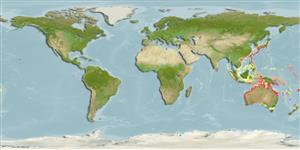Teleostei (teleosts) >
Acropomatiformes (Oceanic basses) >
Pempheridae (Sweepers)
Etymology: Pempheris: Greek, pempheris = the name of a fish (Ref. 45335); analis: The name analis refers to the anal fin, but the exact reference is unknown (Ref. 88976).
More on author: Waite.
Environment: milieu / climate zone / depth range / distribution range
Ecology
Marine; reef-associated; depth range 5 - 40 m (Ref. 2334). Temperate
Southwest Pacific: Australia (including Western Australia and Lord Howe Island), Norfolk Island (Ref. 8879), the Kermadec Islands, and North Island, New Zealand (Ref. 27767).
Size / Weight / Age
Maturity: Lm ? range ? - ? cm
Max length : 20.0 cm TL male/unsexed; (Ref. 2334)
Dorsal spines (total): 6; Dorsal soft rays (total): 9 - 12; Anal spines: 3; Anal soft rays: 30 - 38. This species is distinguished by the following set of characters: all scales strongly ctenoid (rarely 4 or fewer predorsal scales cycloid); no axillary scale; 63-77 lateral-line scales, usually 65 or more; 22-27 scales below lateral line; 30-38 anal-fin rays; ratio of preanal length to anal-fin base length 1.04-1.27; ratio of pelvic-fin origin to anal-fin origin to anal fin base length 0.28-0.44; anterior light organ associated with pyloric caeca absent (Ref. 88976).
A nocturnal species that form aggregations in caves by day and feeds on zooplankton at night (Ref. 2334). The smallest gravid female found was 8.61 cm SL and the largest 14.94 cm SL. These were found among collections made in October through March, although specimens from the early dates carried immature eggs. The smallest specimens, 3.03-3.18 mm SL from the Kermadecs, were collected in June, suggesting that juveniles settle early in the year. Over its entire range, collections are known from September to June (Ref. 88976).
Life cycle and mating behavior
Maturities | Reproduction | Spawnings | Egg(s) | Fecundities | Larvae
Randall, J.E., G.R. Allen and R.C. Steene, 1990. Fishes of the Great Barrier Reef and Coral Sea. University of Hawaii Press, Honolulu, Hawaii. 506 p. (Ref. 2334)
IUCN Red List Status (Ref. 130435)
Threat to humans
Harmless
Human uses
Tools
Special reports
Download XML
Internet sources
Estimates based on models
Preferred temperature (Ref.
123201): 20.3 - 28.4, mean 26.6 °C (based on 226 cells).
Phylogenetic diversity index (Ref.
82804): PD
50 = 0.5000 [Uniqueness, from 0.5 = low to 2.0 = high].
Bayesian length-weight: a=0.01288 (0.00539 - 0.03078), b=3.03 (2.84 - 3.22), in cm total length, based on LWR estimates for this Genus-body shape (Ref.
93245).
Trophic level (Ref.
69278): 3.4 ±0.45 se; based on food items.
Resilience (Ref.
120179): High, minimum population doubling time less than 15 months (Preliminary K or Fecundity.).
Fishing Vulnerability (Ref.
59153): Low vulnerability (10 of 100).
Nutrients (Ref.
124155): Calcium = 24.5 [10.5, 44.8] mg/100g; Iron = 0.254 [0.136, 0.474] mg/100g; Protein = 18.7 [17.4, 19.9] %; Omega3 = 0.298 [0.147, 0.606] g/100g; Selenium = 5.93 [2.64, 14.43] μg/100g; VitaminA = 73.1 [16.8, 325.5] μg/100g; Zinc = 0.577 [0.354, 0.911] mg/100g (wet weight);
